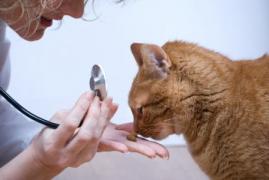The Top 3 Myths about Cancer in Dogs and Cats

The Top 3 Myths about Cancer in Dogs and Cats
November is Pet Cancer Awareness Month. Many pet parents are surprised when their furry friend is diagnosed with cancer because they don’t realize these devastating diseases affect dogs and cats (and most other animals as well). According to the Canine Health Foundation, 25% of the 77 million dogs living in the United States will develop cancer. To help dispel some of the myths surrounding pet cancer, this blogpost will address some of the more common cancer misconceptions.
Myth: A biopsy will cause the tumor to spread
When I recommend a biopsy of a lump or bump to the family of one of my patients, many of them are concerned the biopsy procedure will cause the tumor to spread. First of all, if a biopsy is recommended, it means this diagnostic test is critical to understanding your pet’s cancer. The results of a biopsy provide information on the chances a tumor will spread or come back, both important factors in determining a treatment protocol for your pet. Without that information, treatment is a guessing game. Second, there are established surgical principles to guide the veterinarians in the safe collection of biopsy samples to prevent inadvertent spread of tumor cells.
Myth: Pets can only have one type of cancer
Cancer in pets seems inherently unfair. Why should these cute, wonderful creatures develop such a nasty disease? So two cancers in one pet seem plain wrong. Yet, just last week, I lost a delightful feline patient who originally had a slowly progressive form of lymphoma then developed a highly malignant form of the same cancer. This pair of tumors occur in about 10% of cats with the slowly progressive form of lymphoma.
Myth: Chemotherapy makes pets sick
If you come to the Animal Medical Center to see one of the oncologists on the Oncology Service, we will tell you that only about 10% of pets receiving chemotherapy require hospitalization for treatment-related side effects. While that is good, quantitative information coming from peer-reviewed research by board-certified oncologists, this finding is supported by the qualitative feedback of pet families. 87% of cat owners would treat another cat with chemotherapy for lymphoma. In another study of dogs and cats receiving chemotherapy for a variety of tumors, 94% thought chemotherapy treatment was a positive experience for them and their pet. Finally, when the chemotherapy drug carboplatin was used to treat pets with cancer, 89% of pet owners had no regrets when treating their pet with this anti-cancer drug.
More Pet Cancer Information
I will continue this discussion of cancer in pets on this month’s “Ask the Vet” on SiriusXM Stars channel 109, also available as a podcast. The show will air starting November 13th and the podcast will be available a few days later. My guest will be Dr. Nicholas Bacon of the World Small Animal Association’s Oncology Working Group. Dr. Bacon spearheaded the development of a cancer glossary as a resource for pet families. The glossary will be available to the public on the Oncology Working Group’s website shortly.
There are also numerous resources and past blogposts on cancer in pets on this website, if you’d like to learn more about the topic. Just search “cancer” in the search bar. Here are a couple that other pet owners have found useful:

































